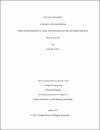Impact Assessment of Land Use Planning on Travel Behavior in Doha, Qatar
| Advisor | Fadli, Fodil |
| Author | Zaina, Samar |
| Available date | 2017-03-13T10:10:25Z |
| Publication Date | 2017 |
| Abstract | In the last decade Qatar has witnessed a rapid growth in its economic and industrial sector as a result of oil and gas economies. This transformed small port cities to large sprawling metropolitan and increased the population. Infrastructure and transportation projects began to develop and the city began to witness down falls in its urban fabric. This is due to the lack of implementation of master plans, poor land use planning and lack of systematic processes, as a consequence to the fast economic and industrial growth. Urban communities in Qatar depend highly on motorized movement and private transport. Therefore, cities like Doha became uninviting and poorly designed. Land use planning and travel behavior are closely associated and influence one another. Land use planning impacts the transportation network, generates travel distance and time, and influence people’s behavior. Hence, direct implications of land use planning decisions are imposed and reflected on travel behavior. Land use planning decisions increase sprawl into dispersed, automobile dependent development. While other land use planning decisions are useful for supporting the ability of smart growth. The thesis aims to examine and investigate the influence of land use factors on travel behavior within old and new urban contexts. In doing so, it introduces the way Qatar spatially organized its city over the years and examines the land use impact on travel behavior. The factors investigated in this thesis include density, regional accessibility, land use mix and roadway connectivity. Using the Qatar Strategic Transport Model data, we observe the relationship between land use attributes and travel behavior. The social economic characteristic and the residential self-selection are considered for home-based work and non-work trips. As an overall, Fereej Abdul Aziz generates a higher density, mixed use and complete planning than Al Messila, and has the potential to achieve a high regenerative symbiotic district. On the other hand, Al Messila has potential to reduce green house gas emission and reduce resource use to assist in decreasing the environmental footprint of the city and urban sprawl. The results indicate the following; density is considered to be the most influential factor of built environment, residential characteristics effect traveler’s decisions, socioeconomic elements are in agreement with the cultural prospect, and the more distant the work place is, the greater the travel distance and travel trips. The study focuses on developing land use policies and recommendations through the assessment of Doha’s current land use conditions and their impact on travel behavior. They look at three dimensions of the urban form including density, diversity and design. The guidelines include; consolidation of urban context via increased density and mixed use planning to enforce stronger design control and increase the security, vitality, and transit system use. It is essential to establish policies that balance household from settling in high density areas, foster location of major traffic, limit new developments and balance jobs and housing. Finally guidelines need to be in place to encourage the use of public transport and cater for pedestrian friendly neighborhoods. |
| Language | en |
| Subject | Land-use Sustainable Development Travel Behavior Urban planning Land use planning Transportation |
| Type | Master Thesis |
| Department | Urban Planning & Design |
Files in this item
This item appears in the following Collection(s)
-
Architecture, Urban Planning and Design [38 items ]


